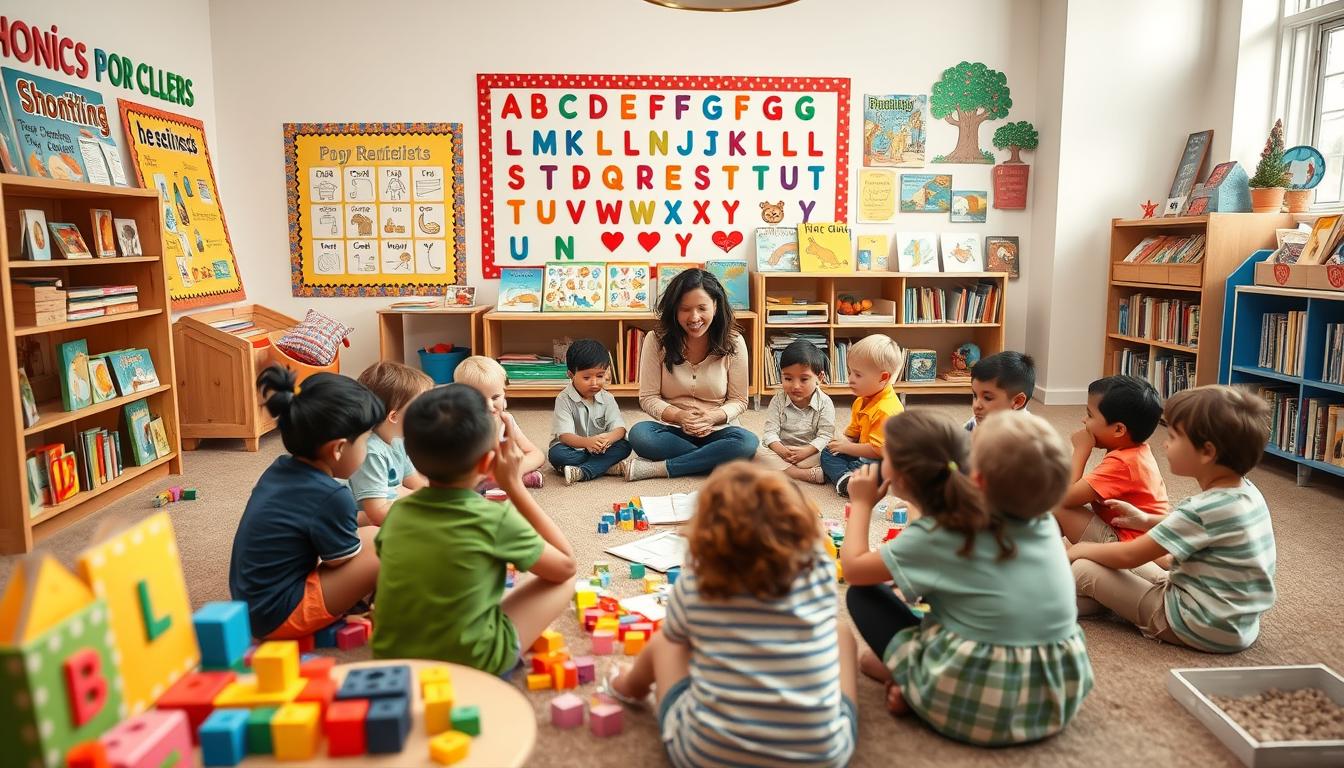Phonics Activities for Young Readers
“The more that you read, the more things you will know. The more that you learn, the more places you’ll go.” – Dr. Seuss’ timeless words remind us that literacy unlocks endless possibilities. For young minds, mastering the connection between sounds and letters is the first step toward this magical journey.
Traditional methods of teaching foundational reading skills often feel rigid, but modern approaches prove they don’t have to be. When kids engage with dynamic, hands-on experiences, they naturally grasp how speech translates to written words. This method isn’t just effective—it’s joyful.
Many assume early literacy work requires drills or flashcards. In reality, playful exploration helps children decode language patterns while building confidence. Think scavenger hunts for letter sounds or story-based games that turn practice into adventure.
This guide reveals how to create moments where learning feels like discovery. You’ll find strategies tailored to visual, auditory, and kinesthetic learners, ensuring no child gets left behind. Let’s reshape what it means to build skills that last a lifetime.
Key Takeaways
- Early literacy success starts with connecting sounds to written symbols
- Interactive methods boost retention and make learning enjoyable
- Customizable approaches address diverse learning styles
- Fluency and comprehension grow through consistent, engaging practice
- Creative techniques replace outdated repetitive drills
Introduction to Phonics Activities
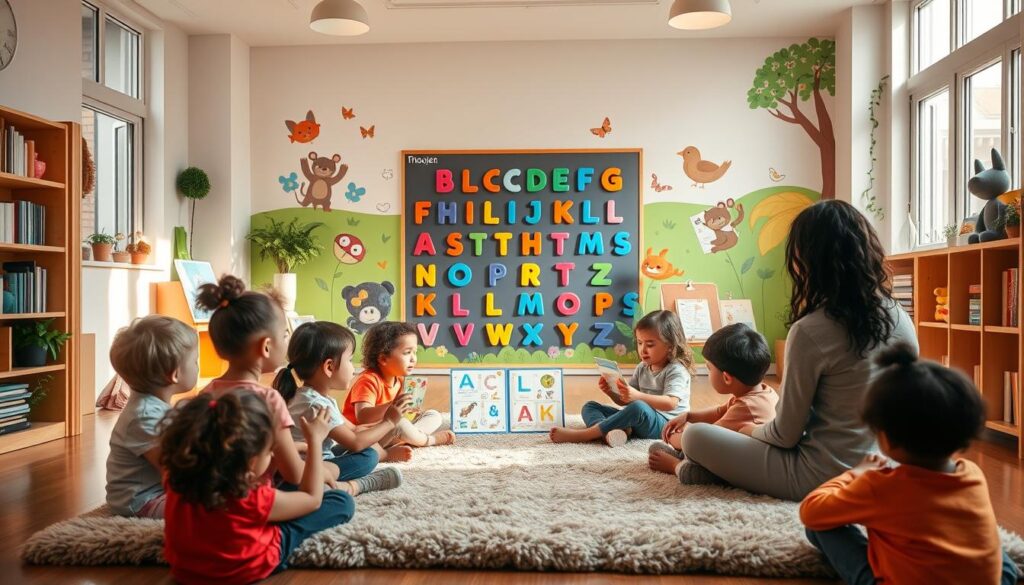
Every spoken word becomes a puzzle waiting to be solved when kids discover how sounds link to symbols on paper. This process turns mysterious squiggles into meaningful messages. The journey begins with listening—can they hear the “sss” in “sun” or the “mmm” in “moon”?
Before diving into letters, young learners need to play with language. Clapping syllables or rhyming games build phonemic awareness. Once they recognize parts of words, connecting those chunks to written characters clicks naturally.
| Stage | Focus | Tools |
|---|---|---|
| 1. Sound Play | Identifying speech patterns | Rhymes, songs |
| 2. Symbol Match | Linking sounds to letters | Alphabet cards |
| 3. Word Building | Combining letters | Magnetic tiles |
Multi-sensory methods work best. Tracing letters in sand helps tactile learners. Whispering sounds engages auditory learners. Color-coded charts attract visual thinkers. This variety ensures every child finds their path to decoding.
Educators love the structure phonics provides. There’s comfort in knowing “ee” usually says its name in words like “bee” or “tree.” Predictable patterns make reading less intimidating. With practice, kids spot these clues independently.
Parents can reinforce these skills at home. Point out letters on cereal boxes or street signs. Ask what sounds they hear in pet names. These everyday moments turn into powerful learning opportunities.
Transforming Boring Phonics into Fun Learning
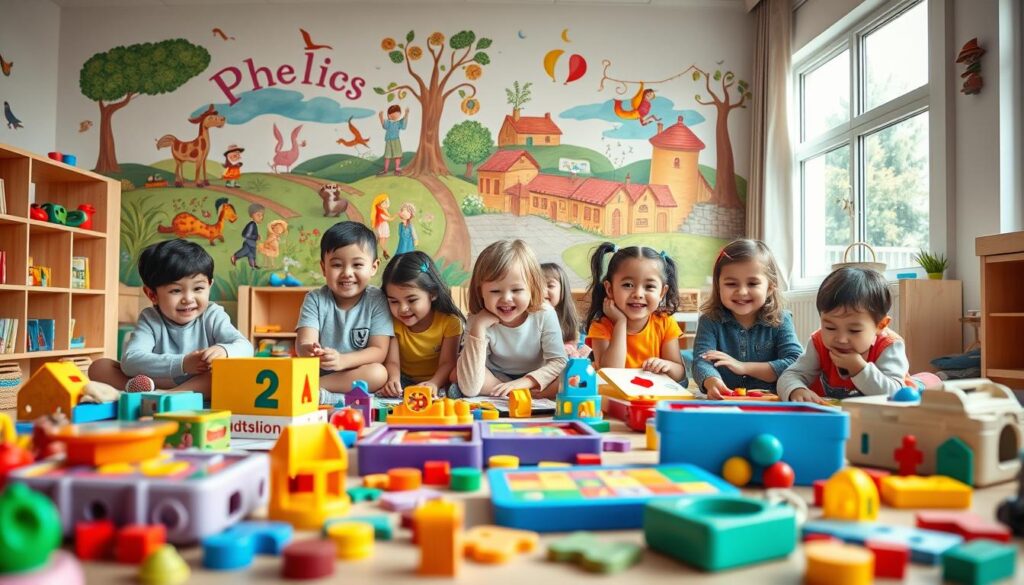
Learning letter sounds doesn’t have to feel like a chore when imagination leads the way. Picture a treasure hunt where children search for objects starting with “ch” or act out words ending with “-ing.” These methods turn routine practice into memorable experiences that stick.
Engagement Through Play
Role-playing scenarios work wonders. A child pretending to be a chef might spell “pan” using letter blocks. Collaborative challenges, like building words with peers, add social excitement. This approach taps into natural curiosity—discovery replaces drills.
Making Repetitive Tasks Exciting
Add movement to letter recognition. Try hopscotch with vowel sounds in each square. Timed challenges using sand timers create friendly competition. Story-based games let kids “collect” sounds to unlock imaginary worlds, masking repetition with adventure.
Variety prevents burnout. Alternate between whisper-and-shout games, tactile letter tracing, and rhythm-based clapping exercises. When instruction feels fresh, young minds stay hungry for more. The result? Skills grow without resistance.
Effective Phonics Instruction for Early Readers
The secret to helping young readers lies in building bridges between spoken language and written symbols. When students grasp that squiggles on a page represent specific sounds, they unlock the code to reading. This foundation turns frustration into confidence.
Letter-Sound Correspondence
Start with simple connections. Students learn that c says /k/ in “cat,” while a makes its short sound. CVC words like “sit” or “mop” work best early on. Their predictable patterns let kids experience quick wins.
Multi-sensory methods boost retention. Trace letters in shaving cream while saying their sounds. Clap syllables to hear word parts. These approaches make abstract concepts tangible.
Decoding and Encoding Techniques
Decoding breaks words apart. Students sound out “d-o-g” slowly, then blend the pieces. With practice, this becomes automatic. Encoding flips the process—hearing “sun” and writing s-u-n.
Try this sequence:
- Match letters to sounds using flashcards
- Build CVC words with magnetic tiles
- Read short sentences aloud together
Educators emphasize consistency. Daily 10-minute sessions work better than weekly marathons. Celebrate when students recognize patterns independently—that’s true mastery in action.
Interactive Phonics Activities for Young Readers
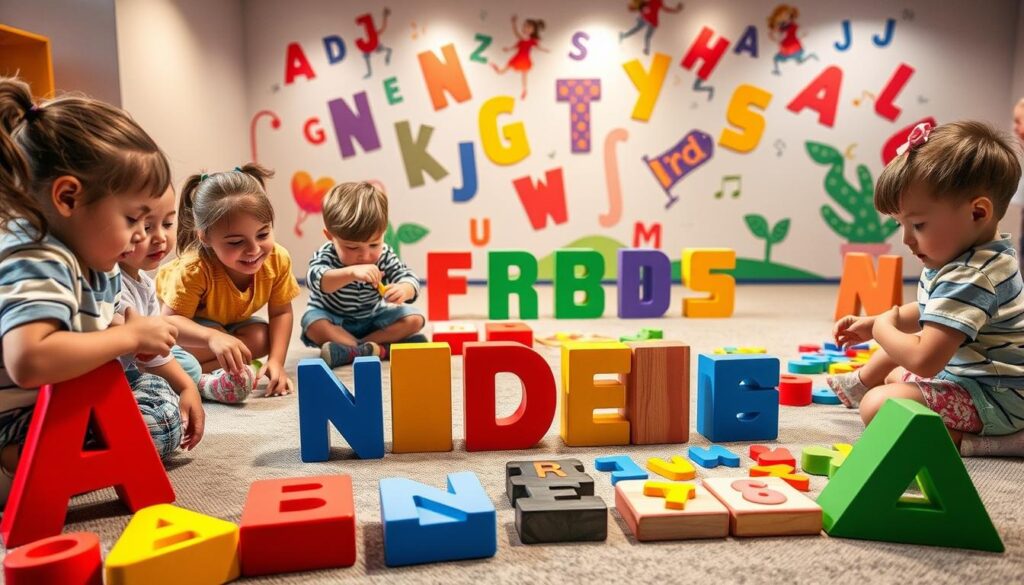
Turning letter recognition into an adventure keeps young minds eager to learn. Four dynamic methods combine movement, collaboration, and friendly competition to strengthen sound-symbol relationships. These approaches let students interact with letters in ways that feel more like play than work.
Letter Labels & Sound Hunts
Letter Labels turns the classroom into a discovery zone. Kids match sticky notes with initial sounds to corresponding images. Is that a “t” on the tiger picture or an “e” near the elephant? Moving around helps cement connections between symbols and real-world objects.
Card Games With Purpose
Go Fish! gets a literacy makeover. Players ask for matches between uppercase and lowercase cards, sharpening visual recognition. The thrill of collecting pairs masks the skill-building happening beneath the surface.
| Game | Skills Developed | Materials Needed |
|---|---|---|
| Letter Says | Auditory processing, quick response | Letter cards |
| Flash Card Race | Sight word recognition, speed | High-frequency word cards |
| Sound Scavenger Hunt | Initial sound identification | Sticky notes, images |
Letter Says adds a twist to Simon Says. When the leader calls, “Letter Says find something that starts with /m/,” students scan their environment. Flash Card Race turns word recognition into a sport—who can grab “the” or “and” fastest? Both games build automaticity through repetition dressed as excitement.
Small group settings let children learn from peers while staying accountable. A blend of individual tasks and team challenges keeps energy high. Best of all, these methods require minimal prep—just cards, creativity, and willingness to make some noise.
Creative Word Building and Decoding Games
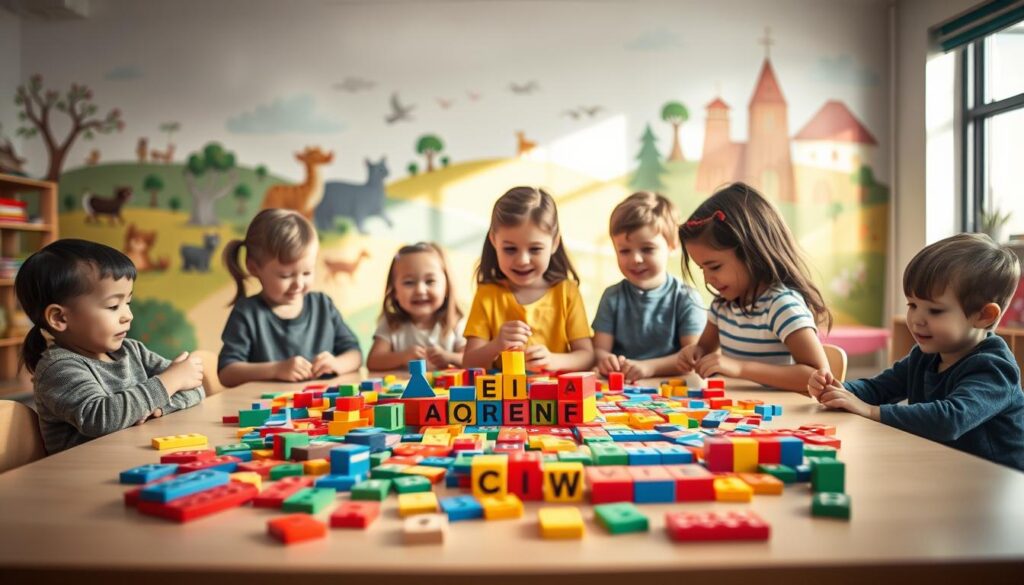
Unlocking the magic of spelling starts with playful experimentation. When kids manipulate letters to form different terms, they discover language’s building blocks. Simple changes create surprising transformations—a powerful lesson in how symbols shape meaning.
Letter Swap Adventures
Start with a basic word like POT. Challenge students to replace one letter at a time. Watch their eyes light up when PIT or COT appears. This reveals how small tweaks yield entirely new words with fresh meanings.
| Original Word | Changed Letter | New Word | Pattern Learned |
|---|---|---|---|
| CAT | C → B | BAT | Consonant substitution |
| HOPE | E → I | HOPI | Vowel shifts |
| SAND | S → L | LAND | Positional changes |
These swaps teach word families and patterns. Kids see how HOT and LOT share structures. Critical thinking blooms as they test which substitutions make real words versus nonsense terms.
Spelling Challenge Tactics
Hand groups identical letters and start a timer. Teams race to build valid words—short ones earn 1 point, longer terms 3 points. Friendly rivalry sparks creativity while reinforcing spelling rules.
Advanced versions add prefixes like UN- or -ING. Suddenly, PLAY becomes REPLAY or PLAYING. This introduces grammar concepts through hands-on discovery. Students grasp how new words emerge from familiar roots.
Through these games, words transform from memorization tasks to exciting puzzles. Confidence grows with each successful combination, proving that language mastery begins with curiosity.
Using Phonics Cards and Flash Cards for Practice
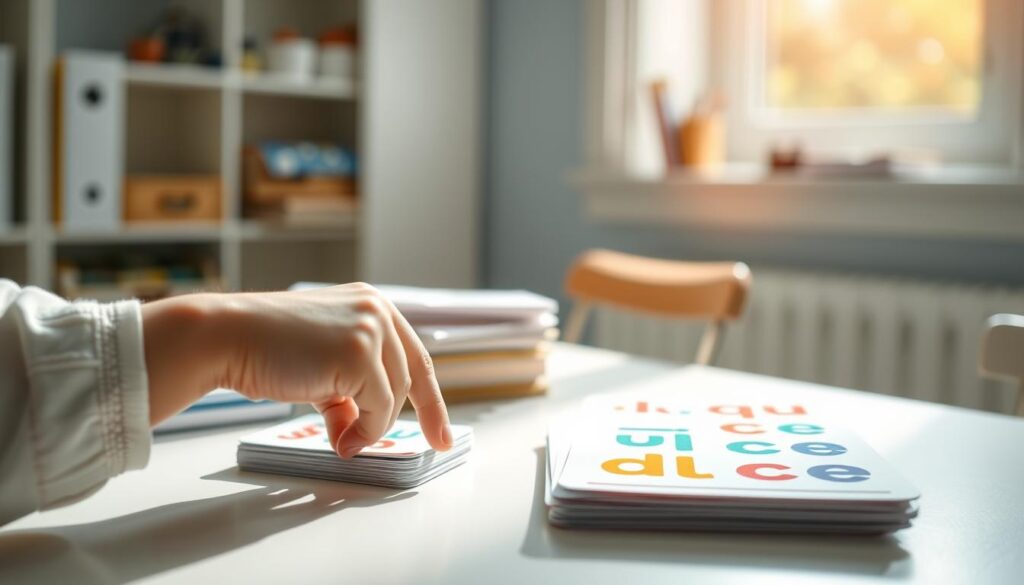
Visual tools turn abstract concepts into tangible learning moments. Colorful cards with bold letters help kids physically connect shapes to sounds. These resources work anywhere—spread them on floors, stick them to walls, or shuffle them during car rides.
Maximizing Learning with Visual Aids
Start with sorting tasks. Ask learners to group cards by vowel sounds or ending blends. This builds pattern recognition. Next, create a list of simple words and challenge them to reconstruct each term using flash cards.
Magnetic letters on refrigerators blend learning into daily life. While making snacks, kids might spell “milk” or “apple.” These casual practice sessions feel like play, not study.
Customize challenges based on skill levels. Beginners match letters to images (C + cat). Advanced learners build compound words like “sunflower.” Rotate activities weekly to maintain interest.
Kinesthetic learners thrive when moving cards between categories. Try timed races—how many words can they build in two minutes? Celebrate progress to fuel motivation.
Consistency matters most. Short, daily practice with visual tools creates lasting connections. Soon, children decode words effortlessly, their confidence growing with each session.
Harnessing Movement with Phonics for Active Learning
Young learners thrive when their bodies and brains work together. Combining physical motion with reading practice creates neural connections that stick. This approach turns static lessons into dynamic experiences where students literally jump into learning.
Reading Hopscotch
Transform any floor space into a literacy playground. Lay down masking tape squares with decodable word cards. Kids hop while sounding out terms like “jump” or “land.” Correct answers earn forward movement—combining exercise with skill-building.
| Game Element | Learning Benefit | Adaptation Tip |
|---|---|---|
| Square Labels | Visual word recognition | Use color-coding for vowel patterns |
| Timed Rounds | Speed and accuracy | Adjust durations per skill level |
| Team Play | Collaborative learning | Assign peer coaches |
Silent Simon
This twist on a classic game removes verbal cues. Hold up cards with action words like “clap” or “stomp.” Children must read and perform the command silently. It sharpens independent comprehension while burning energy.
Movement-based methods particularly help:
- High-energy students who fidget during seated work
- Visual learners who benefit from spatial relationships
- Groups needing collaborative challenges
Educators report better focus during these activities. One teacher noted, “When hands and feet join the learning, minds stay engaged twice as long.” Simple adjustments create lasting impacts—proving motion and mastery go hand in hand.
Incorporating Technology and Interactive Tools
Digital tools are reshaping how young learners master language fundamentals. By blending screen time with skill-building, educators meet students where they’re most engaged. Interactive platforms turn routine drills into quests where cracking a code feels like victory.
Online Resources and Games
Take Rough Riders, where kids chase diamond thieves while tackling digraphs and syllables. The thrill of solving clues masks the real work—decoding complex words. Immediate feedback loops let learners self-correct without pressure, building confidence through trial and error.
Popular options include:
| Game | Skills Targeted | Engagement Hook |
|---|---|---|
| Multisyllabic Words | Open/closed syllable patterns | Word-building puzzles |
| Grammar Police | Compound words & affixes | Action-packed challenges |
| Prefix Popper | Prefix meanings | Balloon pop rewards |
These tools travel well—tablets and laptops let students practice during road trips or rainy days. Progress tracking helps adults spot struggles early. One parent shared, “My daughter asks to play ‘word detective’ games after dinner now!”
Advanced learners tackle multi-syllable terms through tiered levels. Struggling readers get targeted support without singling them out. The variety ensures every child finds a game that clicks, turning screen time into growth time.
Phonics Activities in Kindergarten and Early Grade Levels
Early education thrives when lessons grow alongside young learners. Tailoring approaches to developmental stages ensures students build skills without frustration. Let’s explore how strategies shift from playful exploration to structured patterns across grades.
Foundations for Growing Minds
In kindergarten, focus on sensory-rich experiences. Tracing letters in kinetic sand or matching sounds to animal pictures makes abstract concepts concrete. These methods honor short attention spans while planting literacy seeds.
First grade introduces structured decoding. Use color-coded tiles to show vowel teams like “ea” in “leaf.” Partner games where children swap consonants (changing “cat” to “bat”) reinforce sound-letter relationships. Progress tracking charts celebrate small wins.
By second grade, tackle multi-syllable words through movement. Jump rope while breaking “sunshine” into “sun-shine.” This combines physical energy with pattern recognition. Older students thrive when challenges feel like puzzles rather than drills.
Effective phonics instruction adapts to evolving abilities. What delights a kindergarten class might bore second graders. The key? Match complexity to curiosity—keeping every learner engaged and eager for their next breakthrough.
FAQ
How can I make learning letter-sound relationships engaging for kids?
What are simple decoding strategies for early readers?
Are flash cards effective for teaching new words?
How do I adapt lessons for kindergarteners versus older students?
Can technology support phonics practice without overloading screen time?
What’s a fun way to incorporate movement into word-building exercises?
How can I help a child struggling with spelling rules?

Eduard Kingly is a travel and lifestyle content creator with a focus on personal development and education. He combines firsthand travel experiences with research-driven insights to guide readers in discovering new places, building better habits, and pursuing meaningful learning.

